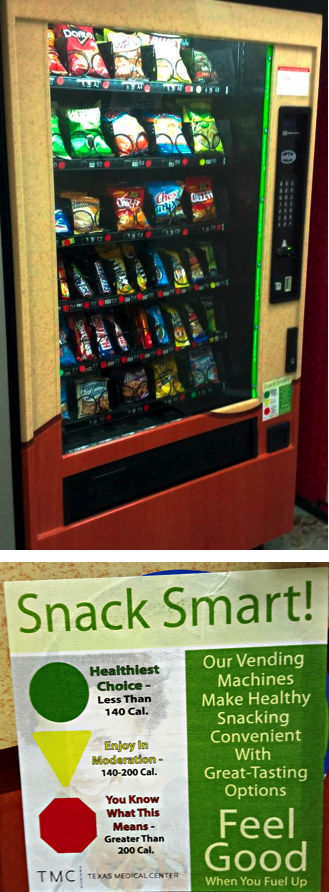By Kristina Michel

Snack machines at five buildings on the University of Houston campus have been fitted with calorie-count stickers as part of a trial program in partnership with the Texas Medical Center to promote health and wellness among faculty and staff.
The calorie-count stickers have been fitted to seven snack machines located in the Ezekiel Cullen Building, M.D. Anderson Library, Philip Guthrie Hoffman Hall, the Welcome Center and the General Services Building. The trial program is one of several health programs being tested across TMC’s 59 member institutions as part of an initiative to improve employee health and wellness.
“This is part of a larger employee health initiative being directed by the Texas Medical Center,” said Charles Layne, chair of the Department of Health and Human Performance and also head of an employee wellness work group under the Division of Student Affairs and Enrollment. “Since we at UH share a mutual interest in employee health and wellness, we were happy to participate.”
Layne has been working directly with the Texas Medical Center in overseeing the implementation of the calorie-count trial program at UH. The goal is to find out whether labeling the calorie levels of snacks will motivate faculty and staff to choose healthier, lower-calorie options.
The stickers are color-coded to represent the calorie range each snack product falls under. A “Snack Smart!” card placed on each snack machine explains the different calorie ranges. Snacks with green stickers are less than 140 calories, snacks with yellow stickers range between 140 to 200 calories, and snacks with red stickers have more than 200 calories.
Layne’s group and UH’s vending partner Canteen will collect sales figures of the seven machines fitted with the calorie-count stickers over a three-month period. They will submit the sales figures to UT Health Science Center, which will analyze the data collected by UH and other participating TMC member institutions.
Though part of a greater health initiative by the Texas Medical Center, UH will also be closely monitoring the calorie-count program’s results.
If it proves successful in making people a little more health-conscious about their snack choices, the program may be extended and expanded to additional vending machines on the UH campus. “If the program proves to be successful, I’m sure we’ll have discussions about expanding it,” Layne said. “The vendor is also interested because if it sees changing behaviors, it can modify its product line to meet consumer needs.”